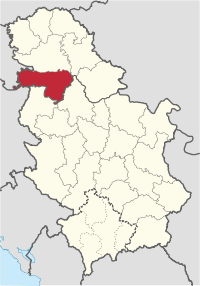Okrug Srem
| Sremski Okrug | |
|---|---|
| State : | Serbia |
| Area : | 3,486 km² |
| Residents : | 335.204 (2002) |
| Capital : | Sremska Mitrovica |
| ISO 3166-2 : | RS-07 |
The Okrug Srem ( Serbian Сремски управни округ Sremski upravni okrug ) is an administrative district and extends in the northern part of Serbia . It encompasses the eastern part of the Syrmia landscape belonging to Serbia and borders in the west with the Croatian Vukovar-Syrmia County . Together with Batschka and Banat, Syrmia forms the three historical regions of the autonomous province of Vojvodina .
It consists of the following city administrations:
population
According to the 2002 census, this district has a population of 335,204. The main administrative seat is the city of Sremska Mitrovica .
The national affiliation consists of Serbs (84.51%), Croats (3.13%), Slovaks (2.78%), Yugoslavs (1.52%), Hungarians (1.26%) and other ethnic groups.
history
The name of the region comes from the Roman Sirmium , today Sremska Mitrovica in Serbia. Sirmium was one of the most important cities in the Roman Balkans , seat of the province of Pannonia inferior and at times also the imperial residence under Galerius . After the collapse of the Roman Empire and the immigration of Slavic tribes in the 7th century, Avars , Bulgarians and Byzantines fought for possession of this fertile region. In the 10th century , the region came completely under the rule of Byzantium, and this established the administrative district of Syrmia.
Between the 11th and 12th centuries Syrmia was contested between Byzantium and Hungary . From the 13th century until around 1521 , Hungarians ruled Syrmia, then the Ottomans until 1698 . With the advance of the Ottomans, a wave of Serbian immigrants from the old Serbian countries that came under Ottoman rule began. In 1471 , under Matthias Corvinus, the Serbian despotate was founded in Syrmia, which existed until around 1540 .
In 1699 the Austrian Habsburgs won the region from the Ottomans. The Austrian Empire was to rule Syrmia until 1918 . The Habsburgs assigned the greater part of Syrmia to the military border and, like in the Banat and the Batschka, settled in several places a. a. Danube Swabians . At the time of Austria-Hungary (ie from 1867 or with the dissolution of the military border in 1881 ) Vukovar was the seat of the Szerém county (Hungarian "Szerém vármegye").
From 1918 Syrmia belonged to the Kingdom of Yugoslavia . 1941 - 1944 it was Croatia the Ustasha affiliated. In 1945 Syrmia established the borders between the Yugoslav republics of Croatia and Serbia. With the disintegration of Yugoslavia, these borders became international state borders. The part of Syrmia belonging to Serbia forms the “Srem” district, which is dealt with in this article.
Culture
The Serbian Orthodox monasteries on the mountain in the Fruška Gora National Park are the most important cultural treasures of this region. The oldest two monasteries are the Grgeteg monastery ( 1471 ) and the Jazak monastery ( 1522 ).
The most historically valuable wall paintings are in the Krušedol monastery. The monastery was completed in 1514 and was considered the foundation of Bishop Maksim Branković and his mother Angelina . The Novo Hopovo monastery from the 16th century is also an important sight. The exact year this monastery was built is unknown. Only the restoration in 1765 is known .
In Sremski Karlovci (which belongs to Syrmia, but is now a district of Novi Sad ), the first Serbian primary school ("Serborum Primum") was founded in 1791 .
economy
The economic focus of the district is the paper and cellulose factory "Matroz", the timber company and the "1. November “Furniture factory.
Largest settlements
(Status: 2002 census)
| Place name ( Serbian / Latin ) | Place name ( Serbian / Cyrillic ) | Place name ( German ) | Residents |
|---|---|---|---|
| Sremska Mitrovica | Сремска Митровица | Syrmisch-Mitrowitz | 39,041 |
| Ruma | Рума | Ruma | 32,125 |
| Inđija | Инђиja | Indjia | 26,244 |
| Stara Pazova | Стара Пазова | Old pasua | 18,628 |
| Nova Pazova | Нова Пазова | New pasua | 18,220 |
| Šid | Шид | Schid | 16.301 |
| Laćarak | Лаћарак | Lacharak | 10,890 |
| Novi Banovci | Нови Бановци | New Banovci | 9,354 |
| Beška | Бешка | Beschka | 6.232 |
| Stari Banovci | Стари Бановци | Old Banovci | 5,442 |
| Golubinci | Голубинци | 5.112 | |
| Vojka | Воjка | 5,043 | |
| Irig | Ириг | Irig | 4,854 |



